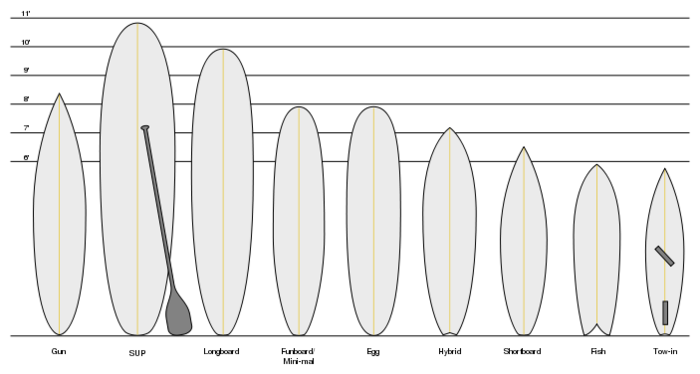Types of Surfboards

Just as there are many different surfing abilities and types of wave, so too are there many different types of surfboards. Choosing the right surfboard for you is essential to enjoying your surfing experience. The main types of surfboards today are the shortboard or thruster, the longboard or Malibu, the fish, the gun, the funboard, and the hybrid. There are also a number of other designs such as the increasingly popular stand-up paddleboard. Surfing a board that is a good fit for your skill and body type, and the prevailing conditions, will allow you to have the most fun in the water.
Shortboard or Thruster
Shortboards are highly manoeuvrable, and suitable for fast, steep waves. Not for the beginner, they sacrifice paddling ease for the sake of speed, power and control; for this reason they are the most popular board for shredding (showing off skill and style) and contest-style surfing. They range from 5 to 7 feet. They usually have a nose rocker, which is a pointy nose and thinner rails. The greater amount of rocker allows it to surf in critical sections of the wave. All shortboards attempt to offer the rider aggressive, vertical surfing, but the category has broadened in recent years to focus on catching waves in less than ideal conditions as well.
Longboard or Malibu
The oldest of modern surfboard designs, these boards date back to Hawaiian nobility. Their nickname as “cruizer” or “log” alludes to their stability in the water. Longboards are 8 to 12 feet long, 20 inches wide, and at least 2.5 inches thick, with a rounded nose. Their extra volume makes them easy to paddle on, and catch waves. Longboards are great for beginners learning wave selection, paddling techniques, and turning basics. Their shape and size excludes the quick turns that are possible on a shortboard, and they can be harder to get “out the back” through the white water and oncoming sets. However, many people ride only on longboards for the love of the smooth style and fluid surfing manner it allows. Most long boarders are content to slide along the wave while walking the length of the board, the sole purpose being to casually enjoy the ride and attempt to plant their toes on the board’s nose (“hanging ten”).
Fish boards are best suited for small to medium-sized waves. They are usually shorter, wider, and flatter than shortboards. They are the best surfboards for beginners because they have plenty of volume and are easier to balance. Fish boards typically have two or three fins, and are extremely manoeuvrable in small to medium-sized surf. They go faster in slower breaking waves, and surf more smoothly than shortboards with their fast and snappy turns. Because they don’t have much rocker, they paddle well, but are difficult in steep hollow surf. The wide surface area of the fish board makes it easier to paddle and catch waves, and allows it to be surfed faster in slower-breaking waves. However, these same design characteristics do not support good performance off the top, or in steep or hollow waves.

Big Wave Gun Board
The “big wave gun” is a board built for speed and the intensity of a big wave surf. With its narrow tail and nose, gun boards range from 6 to 10-foot long, and are designed to help the serious surfer drop into serious waves quickly and to handle huge and fast moving waves with control. The gun has a lot of rocker and usually three or four fins. It contains extra thickness to combat the tendency of smaller boards to start wobbling when riding a really big wave. Any mistakes in big surf can have serious consequences. Also known as the elephant gun, this board is the surfer’s gun for hunting down big surf.
Funboard
Funboard is a general term for all surfboards that allow the rider to catch more waves because of their extra volume. They are perfect beginner’s board because they are wide and stable. They are also suitable for heavier surfers, and people who generally don’t want to put much effort into catching waves. Combining the paddling power of a longboard with the turning ability of a shortboard, funboards are usually 7 to 9 feet long.
Hybrid
The Hybrid surf design mixes the design features from two similar board types. Because there are so many variations of boards that can be classified as hybrids, there is no general description of how they ride. An example of a hybrid surfboard is a mix of the shortboard and the fish, or the shortboard and the longboard. The result of both is a board that has more volume, is suited to heavier surfers, but still has the “feel” of a shortboard. A shortboard/fish hybrid might take the vertical riding of a shortboard and give the rider some extra glide while taking away a bit of drop-in security.
The stand-up paddle board (SUP) has experienced a rapid boom in popularity in recent years. The SUP is a large, wide, buoyant board designed to allow the surfer to paddle while standing up in all kinds of conditions. A paddle and good balance skills are required – the latter can be gained on flat water, enjoying the great view that comes from standing up on the board. Once the paddler has got the hang of the balance required, the SUP can be surfed from really small waves to bigger waves. When surfing a break, SUP surfers have a particular advantage to surfboarders in that they are already standing up, making it easier to see and time the oncoming swells.
SUP lengths vary all the way from 8-foot to 14-foot, and are usually 26 inches wide and 4 inches thick. Their shapes are changing and becoming more varied all the time. Today there are SUPs to suit a wide range of needs, from women’s yoga boards and lightweight children’s boards, flat water and ocean racing, to surfing.
